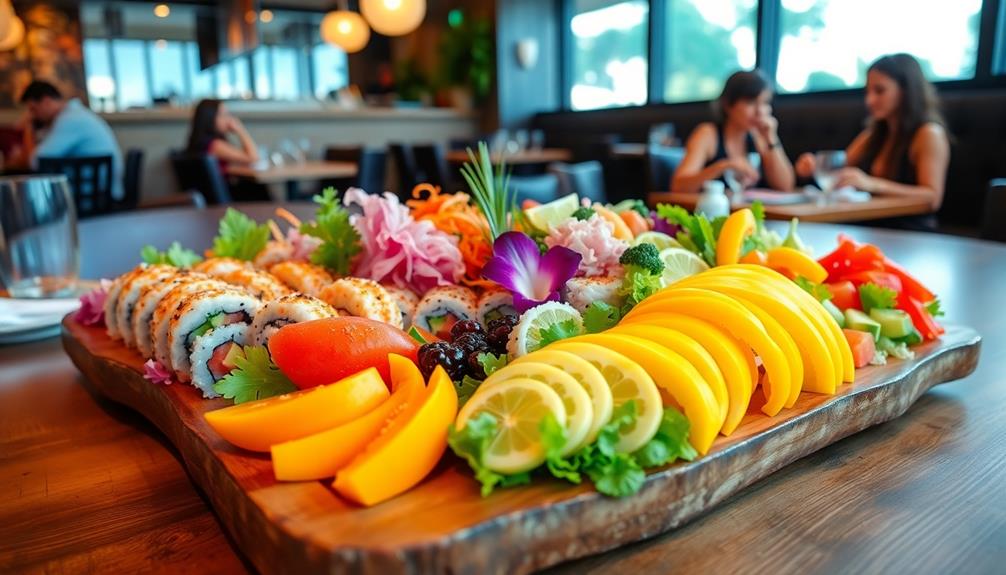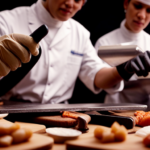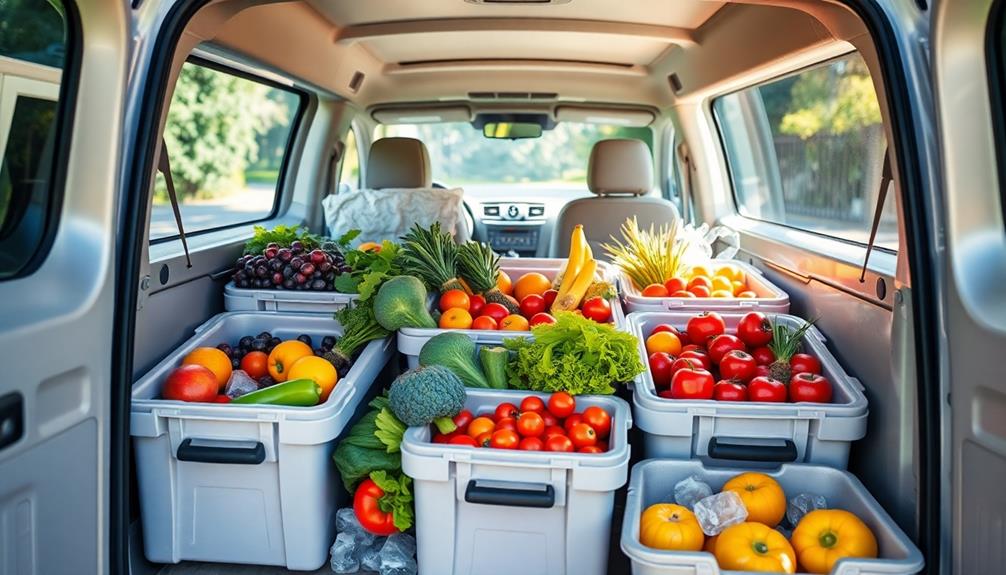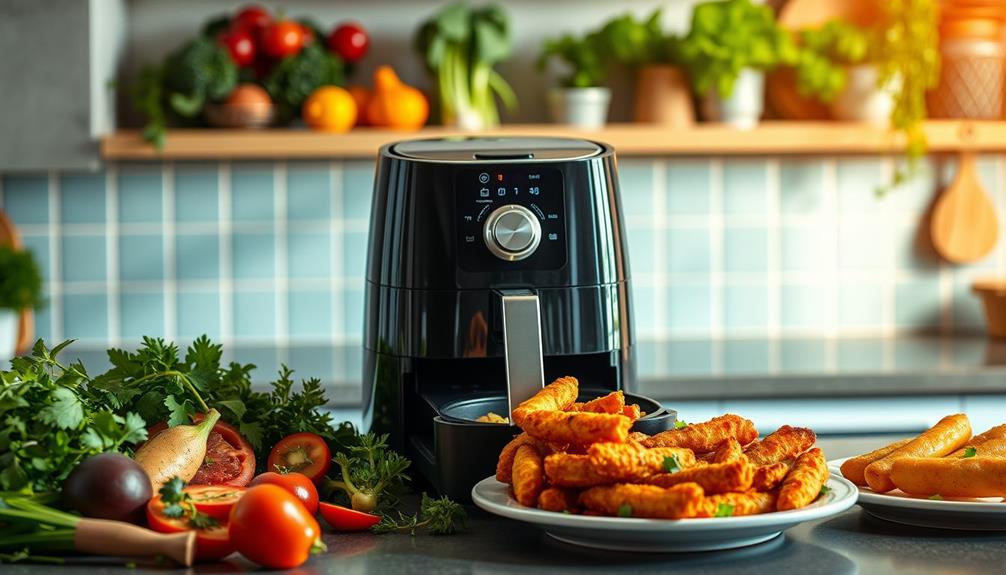When you're dining out, raw food safety is essential to avoid foodborne illnesses. Start by choosing restaurants with high hygiene ratings and observing staff cleanliness and practices. Always ask about their raw food sourcing and handling protocols. Make sure raw items are cooked to the right temperatures and avoid buffets unless they properly monitor freshness. Personal hygiene matters too, so wash your hands before eating. Keep an eye on the cleanliness of tables and utensils. By following these guidelines, you can enjoy your meal with more confidence. There's more to discover about staying safe while dining out.
Key Takeaways
- Choose restaurants with high hygiene ratings and clean dining areas to ensure food safety.
- Confirm that raw foods are stored and prepared at safe temperatures, below 40°F.
- Observe staff hygiene practices, including handwashing and glove use, to assess safety standards.
- Ask about sourcing and handling practices for raw foods to ensure proper safety protocols are followed.
- Be cautious with raw or undercooked seafood, as it carries higher risks of foodborne illnesses.
Choosing Safe Establishments
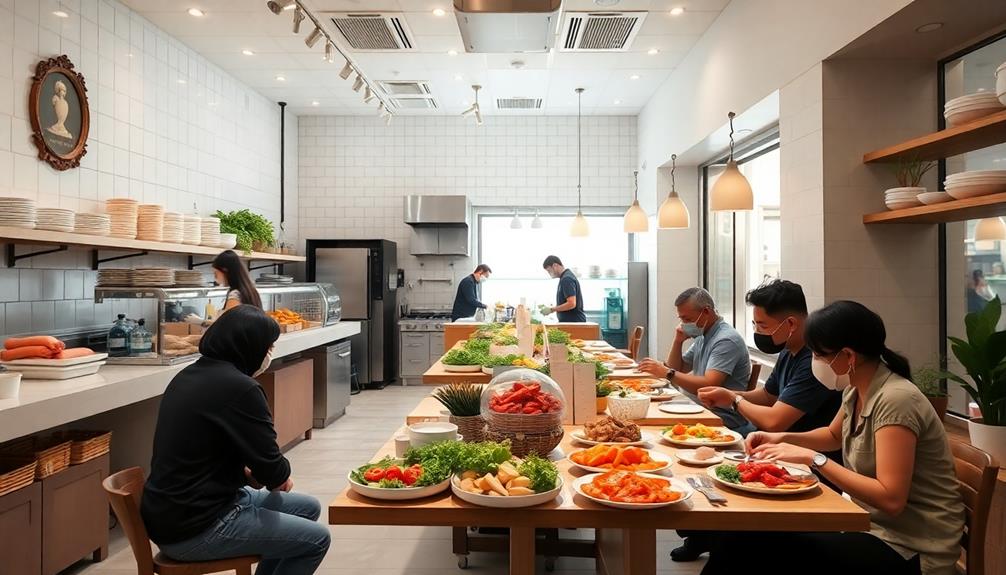
When dining out, it's essential to frequently choose establishments that prioritize food safety. Start by looking for restaurants that display hygiene ratings and recent inspection scores; these indicators signal a commitment to sanitation and food safety standards.
Pay attention to the cleanliness of dining areas, restrooms, and kitchens. A well-maintained environment often reflects the establishment's overall food safety practices.
Next, observe the staff's adherence to personal hygiene standards. Clean uniforms and appropriate glove usage are important for minimizing contamination risks. If you notice staff following these practices, it suggests that they take food safety seriously.
Also, prefer establishments known for serving well-prepared and thoroughly cooked meals. This choice notably reduces your risk of foodborne illnesses linked to raw or undercooked items.
Finally, don't hesitate to inquire about the restaurant's sourcing and handling practices for raw foods. Knowing they follow strict safety protocols to prevent cross-contamination is essential.
Food Preparation and Handling
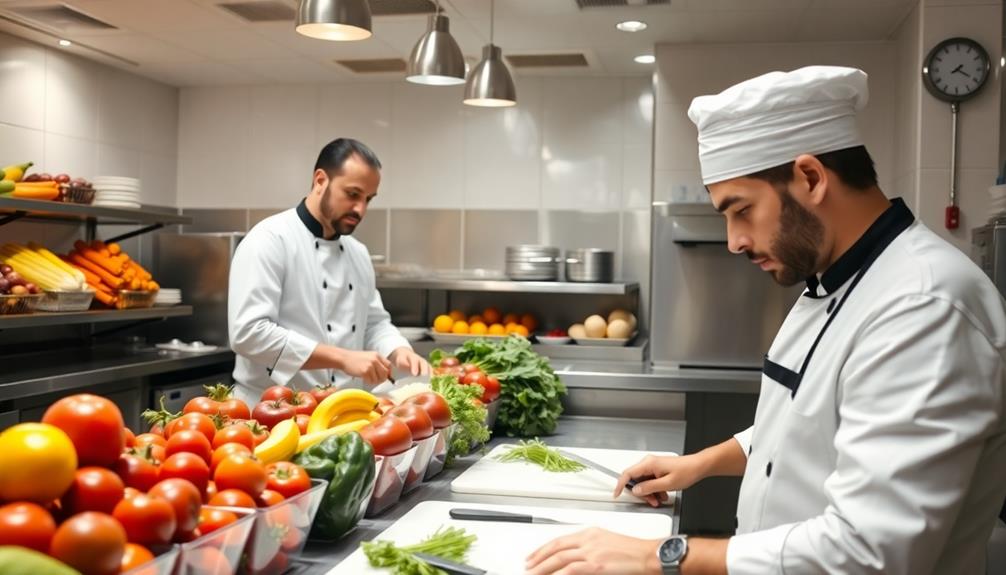
Choosing safe establishments is just the first step in guaranteeing a safe dining experience; how food is prepared and handled plays a considerable role too. When dining out, make sure that raw foods, like meats, seafood, and eggs, are cooked to the right internal temperatures. This practice eliminates harmful bacteria and greatly reduces your risk of foodborne illness.
Be cautious with raw or undercooked seafood, as it poses a greater risk for foodborne illnesses caused by parasites and bacteria. Check the freshness of ingredients by confirming expiration dates and steering clear of any items that look spoiled or discolored.
Salads and raw vegetables should be properly washed to remove potential contaminants. You want your meal to be safe and enjoyable.
Lastly, pay attention to cross-contamination. Guarantee that raw and cooked foods are stored and prepared separately, using designated cutting boards and utensils for each type.
Special Dietary Considerations

Understanding special dietary considerations is vital for a safe and enjoyable dining experience, especially when consuming raw foods. When you dine out, always ask how raw foods, like sushi or salads, are sourced and prepared. This helps guarantee they meet safety standards and reduce the risk of foodborne illnesses.
Additionally, opting for foods with adaptogenic properties can further support your overall health while dining out. Be particularly cautious with raw or undercooked seafood, as these can harbor harmful bacteria and parasites. Opt for reputable establishments that adhere to strict food safety practices.
Buffets can pose higher risks for foodborne illnesses. When choosing a buffet, select options where raw foods are closely monitored for freshness and proper handling to minimize bacterial growth.
If you have allergies or dietary restrictions, always inquire about ingredient substitutions in raw dishes. This is essential to avoid cross-contamination and guarantee your safety.
Lastly, trust your instincts regarding the cleanliness and safety practices of restaurants when considering raw food options. If something feels off, don't hesitate to explore alternative dining choices.
Personal Hygiene Practices
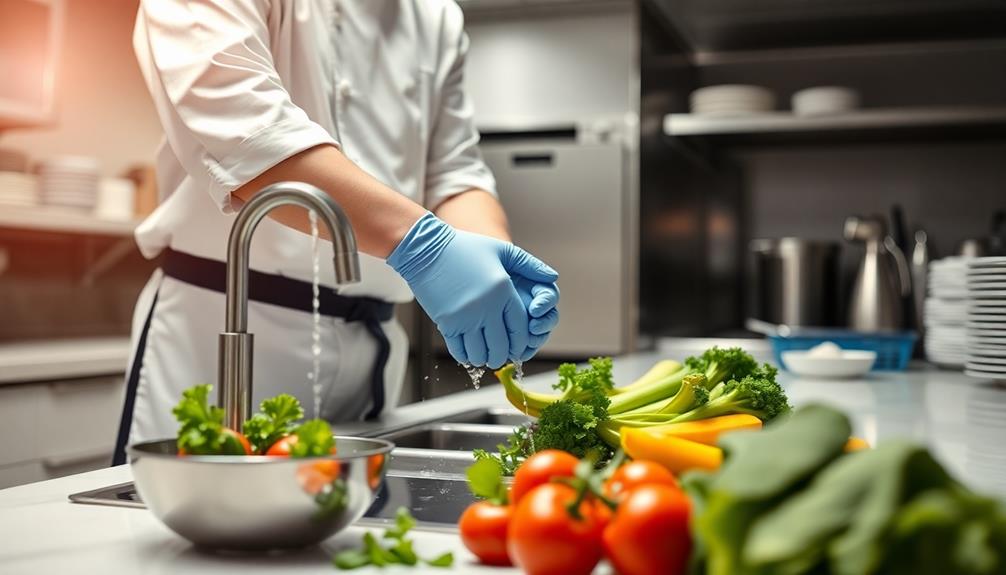
Before you eat, make sure to wash your hands thoroughly with soap and water for at least 20 seconds to eliminate any contaminants.
It's also important to avoid touching your face, hair, or personal items while dining to keep germs from transferring to your food.
Handwashing Before Eating
Practicing good hand hygiene is essential for safeguarding your health, especially before enjoying a meal. Handwashing before eating plays a critical role in removing harmful bacteria that can lead to foodborne illnesses.
When you handle menus or utensils in public settings, your hands can pick up various contaminants. The CDC recommends washing your hands for at least 20 seconds with soap and water to effectively eliminate germs. Additionally, maintaining clean hands can help prevent the transfer of harmful bacteria that contribute to dental issues, such as cavities and gum disease, particularly in children importance of flossing for kids.
If soap and water aren't available, hand sanitizers can be a helpful alternative, but they shouldn't replace proper handwashing. Make it a habit to encourage children and your dining companions to wash their hands before meals. This simple act greatly reduces the risk of transferring harmful contaminants to your food.
Maintaining personal cleanliness, including clean hands, is essential when dining out, especially in establishments that serve raw foods. By prioritizing hand hygiene, you not only protect yourself but also contribute to the safety of those around you.
Avoid Touching Face
One of the simplest yet most effective ways to protect yourself from foodborne illnesses is to avoid touching your face while dining out. When you handle menus or utensils in public settings, your hands can pick up contaminants. If you touch your face afterward, you increase the risk of foodborne illnesses as pathogens can easily enter through your eyes, nose, or mouth.
Additionally, maintaining good personal hygiene practices is vital for overall health, especially when consuming raw foods, as it can help prevent the spread of germs in food environments.
The CDC emphasizes that proper hand hygiene is essential for preventing the spread of germs in food environments. To minimize risks, wash your hands thoroughly, especially after handling raw foods or high-contact surfaces. This habit greatly reduces the likelihood of cross-contamination and subsequent illness.
Encouraging children and dining companions to refrain from touching their faces can enhance overall food safety while you enjoy meals outside the home. It's all about being mindful of your actions and aware of how easily germs can spread.
Water Safety Awareness
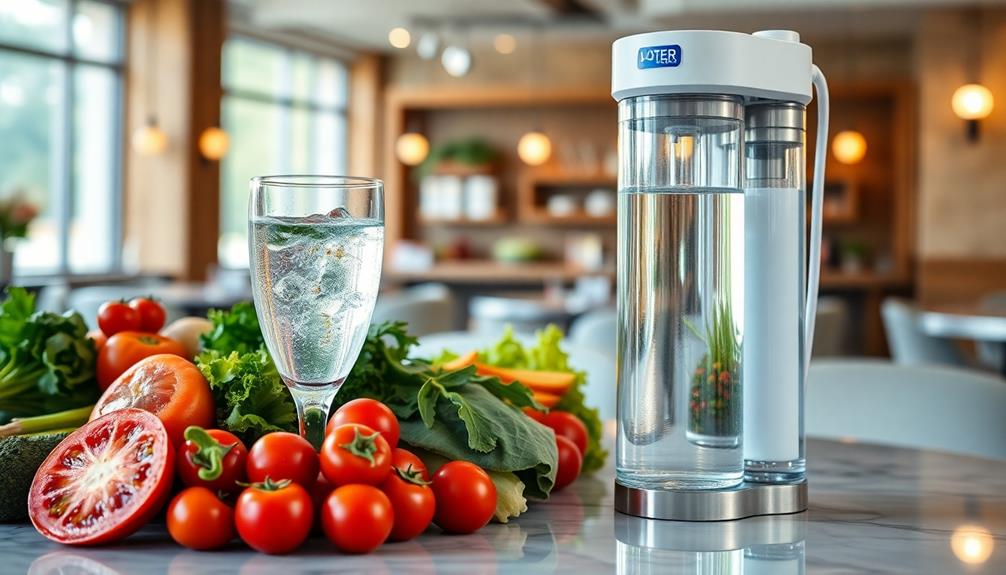
Water safety awareness is essential, especially when dining out in areas where water contamination is a concern. You should always be cautious about the water you consume. In regions with known water issues, it's best to avoid tap water and opt for bottled or purified alternatives. This simple choice can greatly reduce your risk of foodborne illnesses linked to contaminated water.
Stay informed about local water quality reports and advisories. These resources can help you make safer decisions about your drinking water while dining out. Symptoms like nausea and diarrhea can often arise from consuming water that isn't safe, leading to gastrointestinal infections and other health complications.
Regularly check for up-to-date information on food recalls and outbreaks from reliable sources. This vigilance can help you avoid potential waterborne illnesses during your meals.
Understanding Foodborne Illness Risks
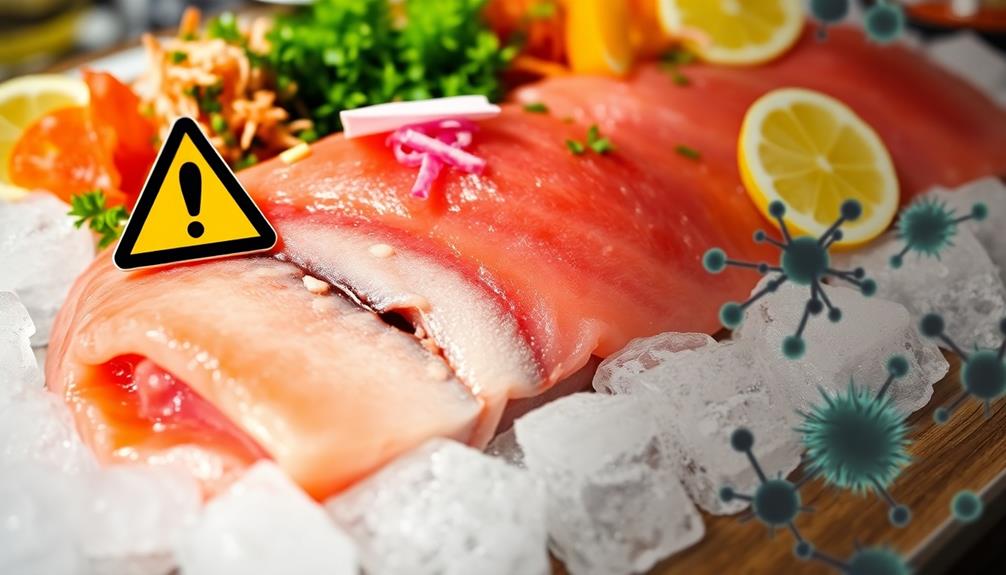
When you eat out, you're often at a higher risk of foodborne illnesses due to improper food handling in restaurants.
Contamination can happen at any point, from sourcing ingredients to cooking, making it essential for you to be aware of prevention strategies.
Staying informed about the freshness and safety of raw foods can help protect you from serious health issues.
Dining Out Risks
Dining out can be a delicious experience, but it also comes with heightened risks of foodborne illnesses. The CDC reports that 70% of outbreaks are linked to restaurants, making awareness of these risks vital.
Here are three key factors to take into account:
- Temperature Control: Foods should be kept out of the danger zone (between 40°F and 140°F) to minimize bacterial growth.
- Raw Foods: Items like seafood, meats, and eggs are often associated with higher risks of foodborne illnesses due to potential pathogens.
- Hygiene Practices: Contamination can occur at any stage of food preparation, so it's essential to observe hygiene in the kitchen and when serving.
When dining out, it's important to be mindful of these risks. If you opt for raw or undercooked dishes, like salads or sushi, remember they're more susceptible to contamination.
Staying informed about food safety practices can help you make safer choices and enjoy your meals with less worry. Always prioritize establishments that adhere to strict food safety protocols for a safer dining experience.
Contamination Sources
Contamination sources are everywhere, and understanding them is fundamental to preventing foodborne illnesses. When dining out, raw foods, particularly seafood and meats, pose significant risks. In fact, the CDC reports that 70% of foodborne illness outbreaks are linked to restaurants, often due to improper handling.
One significant issue is cross-contamination, which occurs when raw foods touch cooked or ready-to-eat items. This can dramatically increase your risk of encountering harmful bacteria.
Temperature control is another crucial factor. The Danger Zone, which ranges from 40°F to 140°F, allows bacteria to multiply rapidly. It's imperative to ascertain that raw foods are stored and prepared at safe temperatures.
Additionally, poor personal hygiene practices among food handlers, like not washing their hands after handling raw ingredients, can spread pathogens and contribute to illness.
You should also be aware of contaminated surfaces, utensils, and equipment used in food preparation. These areas can harbor harmful bacteria, making it fundamental to choose restaurants that prioritize food safety and cleanliness.
Prevention Strategies
Understanding the risks associated with raw foods is essential to preventing foodborne illnesses. When dining out, there are several strategies you can employ to minimize your risk:
- Always choose reputable restaurants that prioritize food safety and hygiene.
- Inquire about their practices for preventing cross-contamination between raw and cooked foods.
- Verify that raw food items are kept at safe temperatures to avoid the danger zone (40°F to 140°F).
When consuming raw foods, especially seafood and undercooked meats, be aware that the Centers for Disease Control and Prevention (CDC) links 70% of foodborne illness outbreaks to restaurant meals.
It's vital to ask questions about how the kitchen handles raw food preparation. Cross-contamination is a significant risk; raw foods should be prepared separately from cooked items to prevent harmful bacteria from spreading.
Additionally, raw food items should come from suppliers who follow strict food safety protocols. Regular staff training on hygiene and safe food handling practices can also make a difference.
Importance of Staff Training
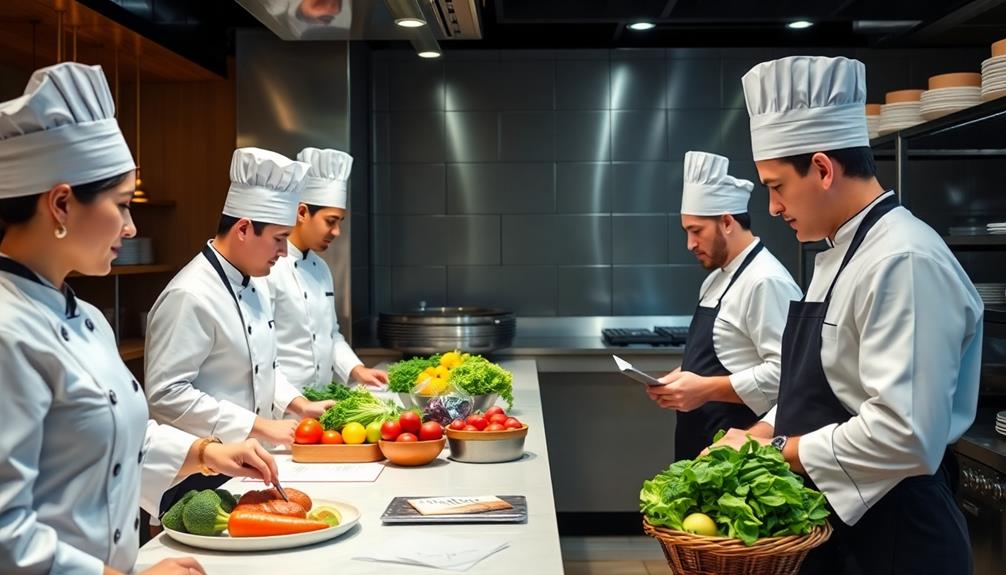
Effective staff training is fundamental for maintaining food safety, especially when handling raw ingredients. Thorough training on food safety protocols greatly reduces the risk of foodborne illnesses. Studies show that well-trained employees are less likely to engage in unsafe food handling practices.
Regular training sessions focused on cross-contamination prevention are essential, as improper practices contribute to 70% of the foodborne illnesses reported by the CDC.
You need to emphasize important temperature control during training. Bacteria thrive in the Danger Zone between 40°F and 140°F, where they can double in number every 20 minutes. Educating employees on the importance of personal hygiene, including frequent handwashing and the proper use of gloves when handling raw ingredients, is crucial to minimize contamination risks.
Ongoing education about the safe preparation and storage of raw foods not only aligns with legal compliance but also meets industry standards. This guarantees your restaurant maintains a high level of food safety and protects its reputation.
Observations While Dining Out
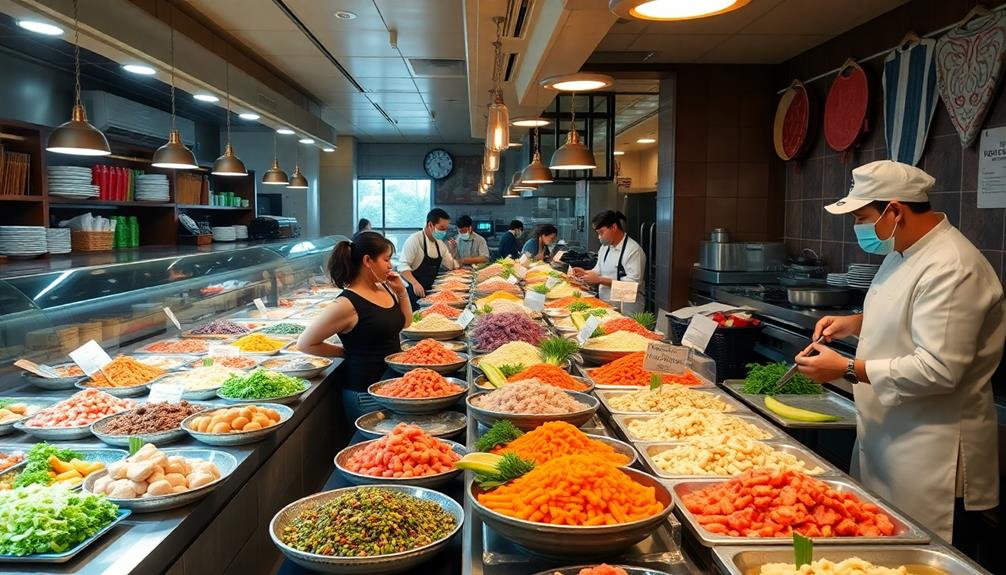
When you're dining out, the environment around you can reveal a lot about a restaurant's commitment to food safety. Here are three key observations to make during your visit:
- Cleanliness: Check the cleanliness of tables, floors, and utensils. A tidy environment often indicates good food safety practices.
- Separate Preparation Areas: Ascertain that raw foods, like salads and sushi, are prepared in a designated area away from cooked foods to minimize cross-contamination.
- Temperature Control: Verify that raw meat, seafood, and eggs are kept at safe temperatures, ideally below 40°F, during service.
Additionally, look for clear labeling and proper handling of raw ingredients, including the use of color-coded cutting boards and utensils to prevent mix-ups.
Pay attention to staff hygiene practices as well; they should wash their hands and use gloves when handling raw foods.
These observations can help you gauge how seriously a restaurant takes food safety, especially when it comes to raw foods. By staying vigilant, you can enjoy your meal with greater peace of mind.
Frequently Asked Questions
How to Avoid Food Poisoning When Eating Out?
To avoid food poisoning when eating out, choose clean restaurants with high hygiene ratings. Check food temperatures, avoid buffets with questionable practices, and guarantee meats and seafood are thoroughly cooked to eliminate harmful pathogens.
What Are the Food Safety Guidelines for Restaurants?
Restaurants should follow strict food safety guidelines, ensuring proper food storage, temperature control, and preventing cross-contamination. Staff need regular training on hygiene practices, using separate utensils, and maintaining safe food handling procedures to protect customers.
What Are Some Tips to Keep You Safe When You Dine Out?
When you're dining out, think of it like steering through a culinary minefield. Choose clean restaurants, watch staff hygiene, and opt for freshly prepared dishes. Your safety's the secret ingredient to enjoying every bite without worry.
What Are the 5 C's in Food Safety?
The 5 C's in food safety are Clean, Cook, Chill, Combat Cross-Contamination, and Certificate. You should wash hands and surfaces, cook food properly, chill promptly, prevent cross-contamination, and guarantee proper certifications for safety.
Conclusion
When dining out, your diligence determines deliciousness and safety. By selecting safe spots, scrutinizing staff practices, and staying savvy about foodborne risks, you can savor your meal without worry. Remember, a little caution goes a long way in ensuring your experience is both enjoyable and hygienic. So, stay sharp, stay smart, and savor the satisfaction of knowing you've made safe choices for your health. Dining out can be delightful when you prioritize food safety!

